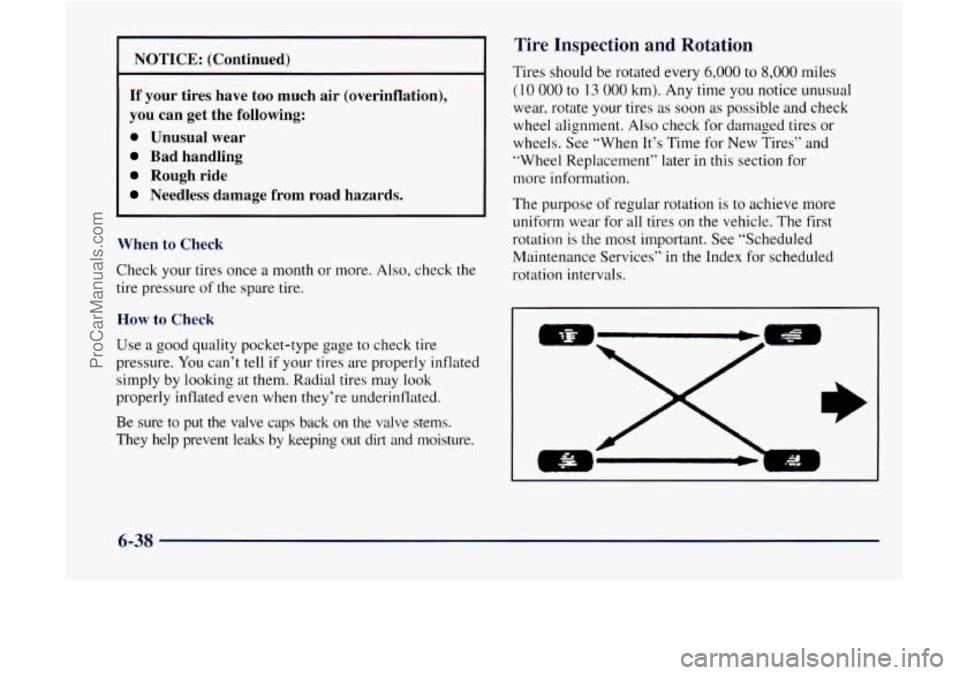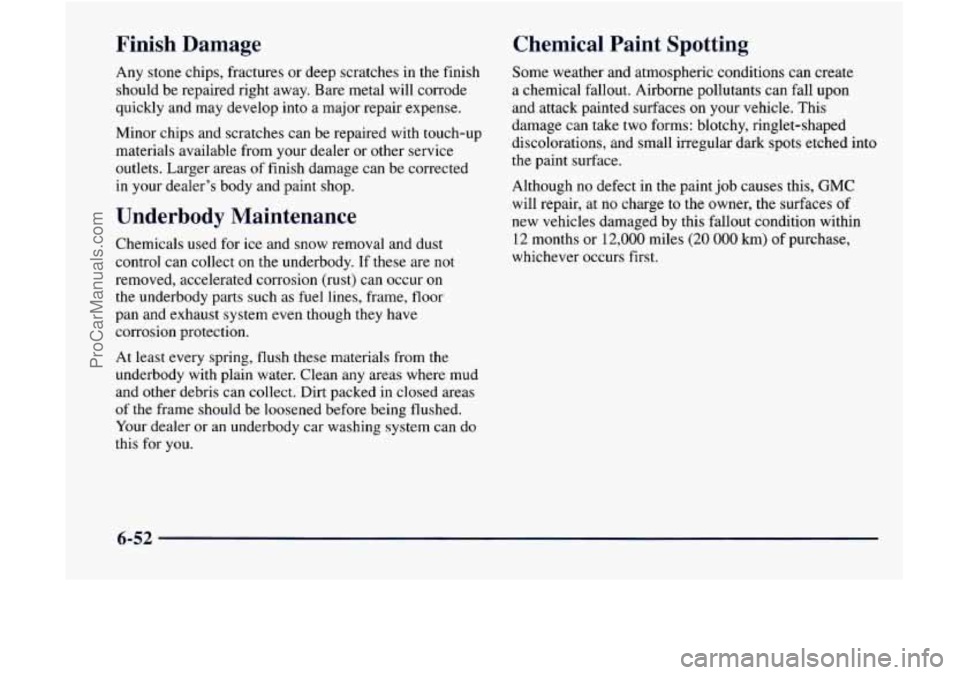Page 281 of 386
Taillamps
1. Open the liftgate.
2. Remove the two screws
from the lamp assembly.
6.
1
8.
9.
Push the new bulb straight into the socket until
it clicks.
Put the socket into the assembly and turn the socket
to the right until
it locks in place.
Install the lamp assembly. Install and tighten
the screws.
Close the liftgate.
Windshield Wiper Blad eplacement
See “Normal Maintenance Replacement Parts” in the
Index
for the proper type of replacement blade.
I NOTICE: I
3. Pull the assembly away from the vehicle.
4. Turn the socket to the left to remove it. Push the tab
in while you turn the socket to the left.
Use care when removing or installing a blade
assembly. Accidental bumping can cause the arm
to fall back and strike the windshield.
5. Holding the base of the bulb, pull the bulb straight
out of the socket.
I. To remove the old wiper blades, lift the wiper arm
until it locks into a vertical position.
6-34
ProCarManuals.com
Page 285 of 386

NOTICE: (Continued)
If your tires have too much air (overinflation),
you can get the following:
0 Unusual wear
Bad handling
Rough ride
Needless damage from road hazards.
When to Check
Check your tires once a month or more. Also, check the
tire pressure
of the spare tire.
How to Check
Use a good quality pocket-type gage to check tire
pressure. You can’t
tell if your tires are properly inflated
simply by looking at them. Radial tires may look
properly inflated even when they’re underinflated.
Be sure to put the valve caps back on the valve stems.
They help prevent leaks by keeping out dirt and moisture.
Tire Inspection and Rotation
Tires should be rotated every 6,000 to 8,000 miles
( 10 000 to 13 000 km). Any time you notice unusual
wear, rotate your tires
as soon as possible and check
wheel alignment.
Also check for damaged tires or
wheels. See “When It’s Time for New Tires” and
“Wheel Replacement” later in
this section for
more information.
The purpose of regular rotation is to achieve more
uniform wear for all tires on the vehicle. The first
rotation is the most important. See “Scheduled
Maintenance Services”
in the Index for scheduled
rotation intervals.
6-38
ProCarManuals.com
Page 299 of 386

Finish Damage
Any stone chips, fractures or deep scratches in the finish
should be repaired right away. Bare metal will corrode
quickly and may develop into a major repair expense.
Minor chips and scratches can be repaired with touch-up
materials available from your dealer or other service
outlets. Larger areas
of finish damage can be corrected
in your dealer’s body and paint shop.
Underbody Maintenance
Chemicals used for ice and snow removal and dust
control can collect on the underbody.
If these are not
removed, accelerated corrosion (rust) can occur
on
the underbody parts such as fuel lines, frame, floor
pan and exhaust system even though they have
corrosion protection.
At least every spring, flush these materials from the underbody with plain water. Clean any areas where mud
and other debris can collect. Dirt packed in closed areas
of the frame should be loosened before being flushed.
Your dealer or an underbody car washing system can do
this for you.
Chemical Paint Spotting
Some weather and atmospheric conditions can create
a chemical fallout. Airborne pollutants can fall upon
and attack painted surfaces on your vehicle. This
damage can take two forms: blotchy, ringlet-shaped
discolorations, and small irregular dark spots etched into
the paint surface.
Although no defect in the paint job causes this,
GMC
will repair, at no charge to the owner, the surfaces of
new vehicles damaged by this fallout condition within
12 months or 12,000 miles (20 000 km) of purchase,
whichever occurs first.
6-52
ProCarManuals.com
Page 308 of 386

Normal Maintenance Replacement Parts
Replacement part numbers listed in this section are
based on the latest information available at the time of
printing, and are subject
to change. If a part listed in this
manual is not the same as the part used in your vehicle
when it was built, or if you have any questions, please
contact your GMC dealer.
Thermostat
......................... 1255905 1
Oil Filter ............................... PF52
Air Cleaner Filter
...................... A1 163C
PCV Valve
.......................... CV746C
Automatic Transmission Filter Kit
...... 24200796
Spark Plugs
.......................... .41-932
Fuel Filter
............................. GF48 1
Front Windshield Wiper Blade
................ Trico (20 inched50.8 cm)
Backglass Wiper Blade . . Trico (14 inched35.6 cm)
Capacities (Approximate)
Cooling System* ............. 11.7 quarts (1 1.1 L)
Crankcase* ................... 4.5 quarts (4.3 L)
Automatic Transmission
(Drain and Refill)*
........... 5.0 quarts (4.7 L)
Differential Fluid ............................
Front ....................... 2.6 pints (1.2 L)
Rear ........................ 4.0 pints ( 1.9 L)
Fuel Tank ..................... 18 gallons (68 L)
A/C Refrigerant ........... 30 oz. or 2 lbs. (0.9 kg)
of R- 134a
*After refill, the level
must be checked.
6-61
ProCarManuals.com
Page 312 of 386
Section 7 Maintenance Schedule
This section covers the maintenance required for your vehicle. Your vehicle needs these services to retain its safety,
dependability and emission control performance.
7-2
7-4
7-5
7-5
7-6
7-6 Introduction
Part
A: Scheduled Maintenance Services
Short Trip/City Definition
Short Trip/City Intervals
Long Trip/Highway Definition
Long Trip/Highway Intervals
7-7
7-27
7-39
7-43
7-45
7-47
Short Trip/City Maintenance Schedule
Long Trip/Highway Maintenance Schedule
Part
B: Owner Checks and Services
Part
C: Periodic Maintenance Inspections
Part
D: Recommended Fluids and Lubricants
Part
E: Maintenance Record
7-1
ProCarManuals.com
Page 313 of 386

I I M PORTANT:
KEEP ENGINE OIL
I
AT THE PROPER
LEVEL AND CHANGE AS
RECOMMENDED
Protection
Plan
Introduction
Your Vehicle and the Environment
Proper vehicle maintenance not only helps to keep your
vehicle
in good working condition, but also helps the
environment. All recornmended maintenance procedures
are inymrtant. Improper vehicle maintenance can even
affect the quality
of the air we breathe. Improper fluid
levels or the wrong tire inflation can increase the level
of emissions fro111 your vehicle. To help protect OLI~
environment. and to keep your vehicle in good
condition, please maintain your vehicle properly.
How This Section is Organized
The remainder of this section is divided into five parts:
“Part A: Scheduled Maintenance Services” shows
what to have done and
how often. Some of these
services can be complex,
so unless you are technically
qualified and have
the necessary equipment, you should
let your dealer‘s service department
or another qualified
service center
do these jobs.
7-2
ProCarManuals.com
Page 314 of 386

A
A CAUTION:
Performing maintenance work on a vehicle can
be dangerous. In trying to do some .jobs, you can
be seriously injured.
Do your own maintenance
work only
if you have the required know-how
and the proper tools and equipment for the job.
If you have any doubt, have a qualified
technician do the
work.
If you are skilled enough to do some work on your
vehicle, you will probably want to get the service
information. See “Service and Owner Publications“
in
the Index. “Part
B: Owner Checks and Services”
tells you what
should be checked and when.
It also explains what you
can easily do to help keep your \:chicle in good condition.
“Part C: Periodic Maintenance Inspections” explains
important inspections that
YOLK dealer’s service department
or another qualified service center should perform.
“Part
D: Recommended Fluids and Lubricants” lists
so~ne recommended products to help keep
your vehicle
properly maintained. These products. or their
equivalents, should be used whether you
do the work
yourself
or have it done.
“Part
E: Maintenance Record” provides a place for
you to ~-eco~-d the maintenance performed on your
vehicle. Whenever any maintenance is performed, be
sure to write
it down in this part. This will help you
determine when your next maintenance should be done.
In addition. it is a good idea to keep your maintenance
receipts. They may be needed to qualify your vehicle for
warranty repairs.
ProCarManuals.com
Page 315 of 386

Part A: Scheduled Maintenance
Services
Using Your Maintenance Schedule
We at General Motors want to help you keep your
vehicle in good working condition. But we don’t
know
exactly how you’ll drive it. You may drive very short
distances
only a few times a week. Or you may drive
long distances all the time in very hot, dusty weather.
You may use
your vehicle in making deliveries. Or
you may drive
it to work, to do errands or in many
other ways.
Because
of all the different ways people use their
vehicles, maintenance needs vary. You may even need
more frequent checks and replacements than you’ll find
in the schedules in this section. So please read this
section and
note how you drive. If you have any
questions
on how to keep your vehicle in good
condition, see your dealer.
This part tells you the maintenance services you should
have done and
when you should schedule them. If you
go to your dealer for your service needs, you’ll know
that GM-trained and supported service people will
perform the work using genuine GM parts. The proper fluids and lubricants to use are listed in
Part D. Make sure whoever services your vehicle uses
these. All parts should be replaced and all necessary
repairs done before you or anyone else drives the vehicle.
These schedules are for vehicles that:
0 carry passengers and cargo within recommended
limits. You will find these limits on your vehicle’s
Certificationflire label. See “Loading Your Vehicle”
in the Index.
0 are driven on reasonable road surfaces within legal
driving limits.
are driven off-road in the recommended manner. See
“Off-Road Driving With Your Four-Wheel-Drive
Vehicle”
in the Index.
0 use the recommended fuel. See “Fuel” in the Index.
Selecting the Right Schedule
First you’ll need to decide which of the two schedules is
right for your vehicle. Here’s how to decide which
schedule to follow:
7-4
ProCarManuals.com